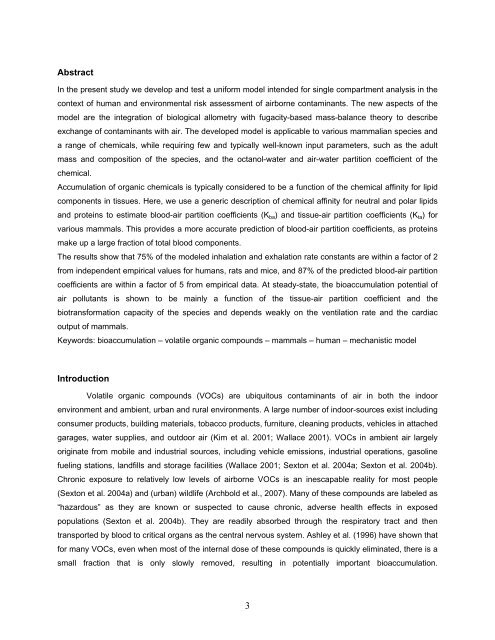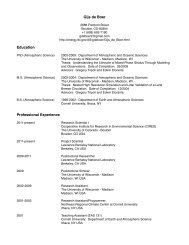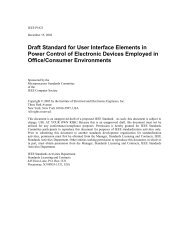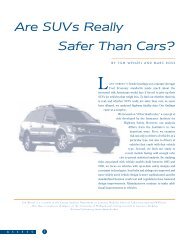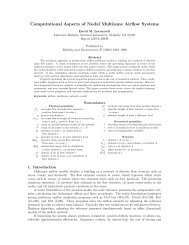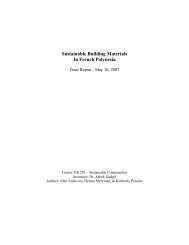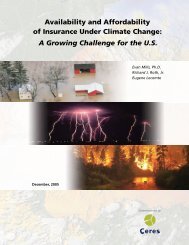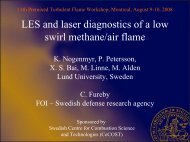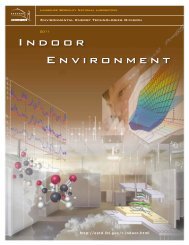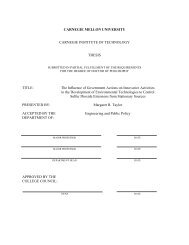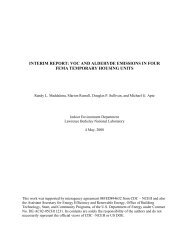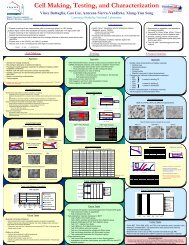Combining Biological Allometry, Chemical Equilibrium And ... - OSTI
Combining Biological Allometry, Chemical Equilibrium And ... - OSTI
Combining Biological Allometry, Chemical Equilibrium And ... - OSTI
Create successful ePaper yourself
Turn your PDF publications into a flip-book with our unique Google optimized e-Paper software.
Abstract<br />
In the present study we develop and test a uniform model intended for single compartment analysis in the<br />
context of human and environmental risk assessment of airborne contaminants. The new aspects of the<br />
model are the integration of biological allometry with fugacity-based mass-balance theory to describe<br />
exchange of contaminants with air. The developed model is applicable to various mammalian species and<br />
a range of chemicals, while requiring few and typically well-known input parameters, such as the adult<br />
mass and composition of the species, and the octanol-water and air-water partition coefficient of the<br />
chemical.<br />
Accumulation of organic chemicals is typically considered to be a function of the chemical affinity for lipid<br />
components in tissues. Here, we use a generic description of chemical affinity for neutral and polar lipids<br />
and proteins to estimate blood-air partition coefficients (Kba) and tissue-air partition coefficients (Kta) for<br />
various mammals. This provides a more accurate prediction of blood-air partition coefficients, as proteins<br />
make up a large fraction of total blood components.<br />
The results show that 75% of the modeled inhalation and exhalation rate constants are within a factor of 2<br />
from independent empirical values for humans, rats and mice, and 87% of the predicted blood-air partition<br />
coefficients are within a factor of 5 from empirical data. At steady-state, the bioaccumulation potential of<br />
air pollutants is shown to be mainly a function of the tissue-air partition coefficient and the<br />
biotransformation capacity of the species and depends weakly on the ventilation rate and the cardiac<br />
output of mammals.<br />
Keywords: bioaccumulation – volatile organic compounds – mammals – human – mechanistic model<br />
Introduction<br />
Volatile organic compounds (VOCs) are ubiquitous contaminants of air in both the indoor<br />
environment and ambient, urban and rural environments. A large number of indoor-sources exist including<br />
consumer products, building materials, tobacco products, furniture, cleaning products, vehicles in attached<br />
garages, water supplies, and outdoor air (Kim et al. 2001; Wallace 2001). VOCs in ambient air largely<br />
originate from mobile and industrial sources, including vehicle emissions, industrial operations, gasoline<br />
fueling stations, landfills and storage facilities (Wallace 2001; Sexton et al. 2004a; Sexton et al. 2004b).<br />
Chronic exposure to relatively low levels of airborne VOCs is an inescapable reality for most people<br />
(Sexton et al. 2004a) and (urban) wildlife (Archbold et al., 2007). Many of these compounds are labeled as<br />
“hazardous” as they are known or suspected to cause chronic, adverse health effects in exposed<br />
populations (Sexton et al. 2004b). They are readily absorbed through the respiratory tract and then<br />
transported by blood to critical organs as the central nervous system. Ashley et al. (1996) have shown that<br />
for many VOCs, even when most of the internal dose of these compounds is quickly eliminated, there is a<br />
small fraction that is only slowly removed, resulting in potentially important bioaccumulation.<br />
3


